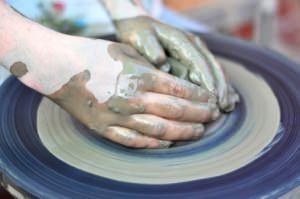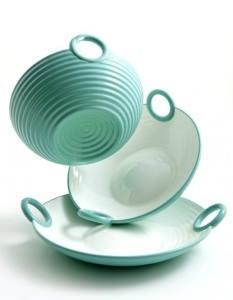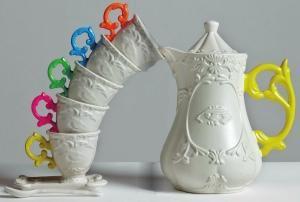Ceramic tableware
Post from EditorialsThe pottery has always been the material of tableware: some brands will revisit forms, combine with other materials to create new and original products.
Despite the advent of new materials, ceramics remains the basic element par excellence of tableware, especially in our country, where there is a strong tradition and pleasure in 'preparing the table with elegance and taste.
What is ceramic and how it is processed
 It is an inorganic compound, has a high workability that, once cooked at high temperatures, assumes all conformations desired.
It is an inorganic compound, has a high workability that, once cooked at high temperatures, assumes all conformations desired.
Where the processing is done by hand, according to tradition, it is necessary to use plaster molds that allow the formal control of the object.
Once out of the part from the mold, it is cleaned and finished by hand and, once dried, can be cooked in the oven.
The enameling is done by immersing the parts in tanks containing liquid enamel. Firing the pieces must be very careful not to approach too greatly, would otherwise melt together with the consequent inability to detach once cooled.
Finally, if required, you can decorate the product by hand with a brush.
 There are many types of ceramic, but the most valuable in the field is certainly the porcelain, consisting of kaolin and feldspar, whose origin goes back to the East.
There are many types of ceramic, but the most valuable in the field is certainly the porcelain, consisting of kaolin and feldspar, whose origin goes back to the East.
Due to the high ductility of the material, the ceramic is used by artists and artisans to create products with a high level of creativity of plates, cups, dishes, utensils ... Several are the products that we find in our homes and are implemented by local workers or specialized companies.
Also in this field, to enhance the talents and focus on quality, it is necessary to investigate the origin of the goods: Made in China often, thanks to a significant reduction in the price, due to the standardization of the design process, the road can be more sector at the expense of small local.
To this end, in Italy, has created a brand of artistic and traditional ceramics, Ancient lands of ceramic production, established by Decree of the Minister of Industry, Trade and Crafts of June 26, 1997, in which they were inserted most important centers of ceramic production. Among them: Caltagirone, Pesaro, Faenza, Orvieto, etc..
New ceramic in table
 Among these realities and across many companies, Bosa over thirty years creates artistic ceramics in Borso del Grappa, a town in Veneto which suffers from one side of the ceramic tradition of Bassano or by the cosmopolitan spirit of Venice.
Among these realities and across many companies, Bosa over thirty years creates artistic ceramics in Borso del Grappa, a town in Veneto which suffers from one side of the ceramic tradition of Bassano or by the cosmopolitan spirit of Venice.
The Bosa products are made entirely by hand and they are often enriched with the addition of precious materials and decorated with enamels produced in the laboratory in order to have a range of colors of their own.
Bosa is present in more than 50 countries through a policy of modern marketing that allows the company structure, small but modern, to oversee various niche markets with a wide range of products, and to collaborate with the best designers: Marco Zanuso jr ., Satyendra Pakhal?, Patricia Urquiola, Marco Morosini, Sam Baron, Luca Nichetto, Jaime Hayon.
One of the products of their line is by Alaya basketball by Satyendra Pakhal?, which draws a line of baskets fruit bowls ceramic with side handles and with the possibility of coating the outside of coats of different colors.
 In line with the tradition that objects with clean lines and rounded, LSA International , inspired by the natural beauty, makes the line Dine designed by Creative Director, Monika Lubkowska-Jonas, which is evident in the combination of white porcelain with wood natural oak, FSC ? and untreated to keep all of its charm.
In line with the tradition that objects with clean lines and rounded, LSA International , inspired by the natural beauty, makes the line Dine designed by Creative Director, Monika Lubkowska-Jonas, which is evident in the combination of white porcelain with wood natural oak, FSC ? and untreated to keep all of its charm.
Thanks to its infinite combinations, Dine is suitable for both casual and fine dining.
The prices are very affordable and vary depending on the selected product: ? 51.50 the bowl, the teapot ? 29.00, ? 28.00 rectangular tray, and set dressings ? 51.50.
Finally we mention Seletti , known for his collaborations with important design and famous for the creation of services for the table lines are always innovative.
And how not to renew the classical union-porcelain tea service by revisiting the classic cups?

The line consists of wares cup, saucer and spoon, teapot and sugar brings all made ??of fine china but with handles in contrasting colors green, yellow, orange, blue or fuchsia.
In short, there is no limit to the imagination, not even on the table, where the classic forms we are used to be rethought, magazines, svecchiate always focus on the quality of the raw materials used.
79402 REGISTERED USERS










